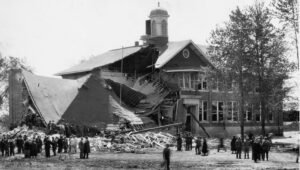Bath School Massacre 1927: America’s Deadliest School Attack
Introduction: A Forgotten Chapter of American History
When people think of mass violence in American schools, names like Columbine, Sandy Hook, and Uvalde dominate the conversation. Yet, long before these tragedies, the Bath School Massacre 1927 shocked the nation. In a peaceful farming town in Michigan, the deadliest school attack in U.S. history took place, claiming 45 lives, most of them children. This article explores the chilling story behind the Bath School Massacre, its causes, aftermath, and lessons that still resonate today.

Setting the Stage: Life in 1920s Bath Township
The 1920s in America — the Roaring Twenties — brought immense growth and prosperity. However, not everyone shared the boom. Rural communities like Bath Township struggled with rising taxes, farm debts, and a slow transition into modernization. In 1922, Bath decided to consolidate its scattered one-room schoolhouses into the new Bath Consolidated School — a move that was progressive but financially burdensome for farmers already on the brink.
One man, Andrew Kehoe, would let this resentment fester into tragedy.
Who Was Andrew Kehoe: The Mind Behind the Massacre
Andrew Philip Kehoe, born in 1872, was an intelligent but troubled individual. Despite his education in electrical engineering, he returned to farming life — a path he found increasingly frustrating. Known for his short temper and vindictive behavior, Kehoe harbored deep grudges, especially towards taxation and local government officials.
- He was burdened by mortgage debts.
- His wife, Nellie, suffered from chronic illness, draining their finances.
- He lost a key election for Township Clerk — a blow to his ego he could not forgive.
Bitterness consumed Kehoe, and he began to plan an act of unparalleled violence.
Planning the Unthinkable: Kehoe’s Deadly Plot
Unlike impulsive modern attackers, Kehoe’s scheme was chillingly methodical. For over a year, he used his access as the school board treasurer to secretly plant explosives in the school’s basement. He wired dynamite and pyrotol throughout the structure — a slow, deliberate preparation for mass murder.
Simultaneously, Kehoe rigged his farmhouse and property with explosives, ensuring there would be no home to return to after the carnage.
The Day of Horror: May 18, 1927
5:45 AM: Farm Explosion
Neighbors awoke to see Kehoe’s farm engulfed in flames following a massive explosion. The fire served as a deadly distraction from the true horror still to come.
8:45 AM: School Explosion
Suddenly, a massive blast tore through the Bath Consolidated School’s north wing. The walls crumbled, the roof collapsed, and dozens of children and teachers were trapped or killed instantly. Screams filled the air as panicked parents and townspeople rushed to rescue survivors.
9:30 AM: Final Attack
Kehoe, having loaded his truck with explosives and shrapnel, drove to the school ruins. When Superintendent Emory Huyck approached him, Kehoe triggered another explosion, killing them both and several others nearby.
Hidden Danger
Later investigations revealed 500 pounds of unexploded dynamite under the south wing, indicating the devastation could have been even worse.
The Human Cost: Casualties and Survivors
- Deaths: 45 people (38 children, 6 adults, Kehoe himself)
- Injured: Over 58, with many facing lifelong disabilities
Families were shattered. Some parents lost all their children in a single morning. The heartbreak resonated nationwide, though limited media technology kept it from becoming as deeply embedded in public consciousness as later tragedies would.
Understanding Andrew Kehoe’s Motive
“Criminals are made, not born.” — Sign found at Kehoe’s destroyed farm.
Kehoe’s motives were a poisonous cocktail of:
- Financial hardship
- Hatred of taxes
- Mental instability
- Personal vendetta against the school and township
There were warning signs: animal cruelty, violent disputes, and increasing isolation. Yet no one foresaw the scope of his wrath until it was too late.
Aftermath: Rebuilding from Ruins
Despite the unimaginable grief, Bath Township showed remarkable resilience. Donations from across America funded the construction of a new school — the James Couzens Agricultural School — by 1928. A small memorial now stands to honor the victims.
The Bath School Massacre spurred early discussions around school safety, mental health awareness, and the societal costs of ignoring signs of despair and rage.
Lessons from the Bath School Massacre 1927
- Mental Health Awareness: Communities must be proactive in addressing mental health issues.
- Economic Stress: Financial despair can have catastrophic social consequences.
- Importance of Community: Bath Township’s unity demonstrated the power of resilience.
- Watch for Warning Signs: Retrospective analysis of Kehoe’s behavior could have potentially prevented tragedy.
Conclusion: A Legacy of Pain and Hope
The Bath School Massacre 1927 remains a powerful, if largely forgotten, lesson in American history. Long before today’s tragic mass shootings, Bath Township endured the worst horror imaginable at the hands of a man fueled by rage and despair.
By remembering Bath, we not only honor the innocent lives lost but also reinforce our commitment to nurturing empathy, addressing mental health crises, and creating communities where violence has no place to thrive.
“A broken mind, left unheard, can tear apart even the strongest communities. We must listen before it’s too late.”
Read more thought-provoking history stories on AtrangiSansar Blog.
Learn more details about the Bath School Disaster on Wikipedia.